Touring the rugged and raw terrain of the north of Scotland, the huge variety of sights and activities that you will find will keep you entertained for days on end. From crashing waterfalls to ancient castles, the popular North Coast 500 road trip has it all.
Continuing north from the city of Inverness, the road soon meets the sea as you wind your way towards the northeast corner of mainland UK. It is here that the landscape begins to change, leaving behind the normality of southern and central Scotland and entering into the remote, rugged and almost mystical terrain of the North Coast 500.
One particular stop that cannot be missed on your North Coast 500 road trip is the hidden staircase of the Whaligoe Steps, just south of the small town of Thrumster. Plan your visit to this manmade wonder with this complete guide to the Whaligoe Steps, including what they are, how to find them and what other North Coast wonders lie in this area.
Get planning your epic North Coast 500 road trip with our guide to the Best Planning Tips
No time to read now? No problem, save a pin to your Pinterest board for later!


A Complete Guide to Visiting The Whaligoe Steps
Hidden on the eastern edge of northern Scotland is one of the most remarkable manmade constructions in the United Kingdom. The winding, limestone staircase of the Whaligoe Steps dates back hundreds of years, to the days when this tiny harbour was one of the most important in the region. In this guide, we will go into more detail on the following:
Table of Contents
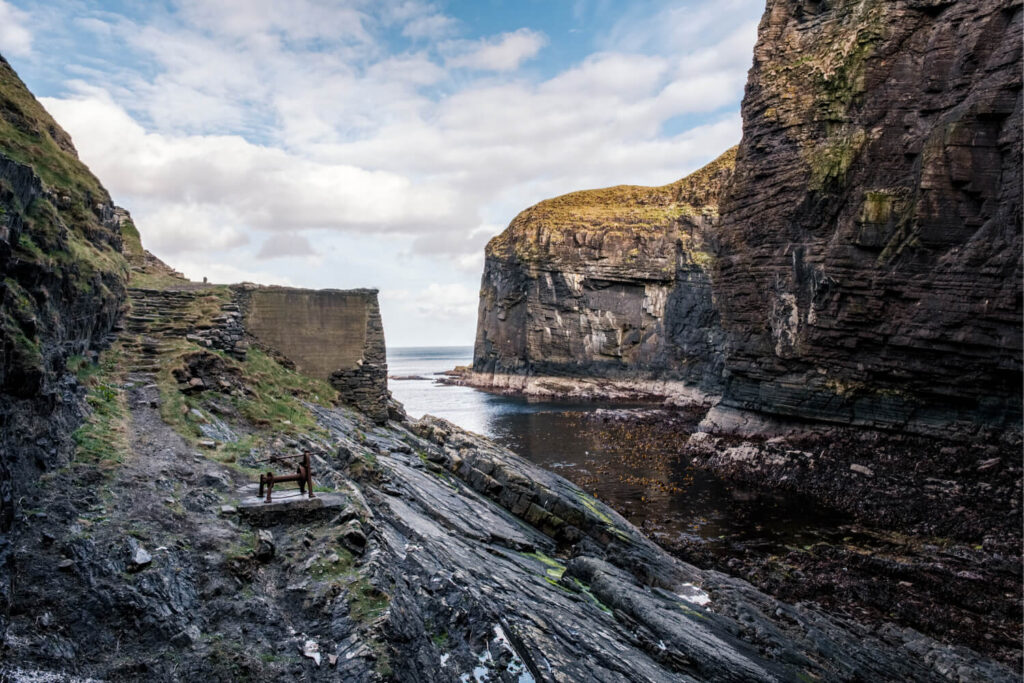
Planning Your Trip
We use the below booking platforms to plan our trips. We hope you find them useful too!
Where to Stay on the North Coast 500
There is a wide range of accommodations around the NC500 route, so you will not be short on options. Depending on how long you are spending in each area will depend on how long you spend in that location. It is worth bearing in mind that some accommodations will require you to stay a minimum number of nights so it is worth researching this when you are planning your North Coast 500 itinerary.
Our new book North Coast 500 Where to Eat and Stay shares the best places to eat and stay around the NC500 and includes whether places are dog friendly, accessible, have wifi and EVC ad whether they cater to dietary requirements. This paired with our own Destination Nc500 is the perfect NC500 combo package for planning your trip.
The remoteness in the highlands of Scotland will leave you with little choice of accommodation in each location along the NC500, however, there are still enough options to choose from to ensure a comfortable trip. These are mostly in the shape of B&Bs, Airbnbs, converted cottages and other quirky accommodations.
History of the Whaligoe Steps
The ancient stones of the Whaligoe Steps have wound their way down the cliffside of Scotland’s northern region for over 200 years. In 1786, the Scottish engineer Thomas Telford prospected the small harbour of Whaligoe as he toured the northern coastlines for the Northern Fishing Society.
Despite his judgement of the Whaligoe cliffs as a “terrible spot” for a harbour, Captain David Brodie decided he would invest in the creation of a series of steps and a mooring station at the bottom. After investing £8 in the creation of the 330 limestone steps of Whaligoe, the mooring eventually grew to hold 14 boats by 1814.
This harbour slowly fell into disuse over the years with no more boats to moor here, and it was eventually abandoned later in the 19th century. From 1998, local volunteers and historians have worked on the steps and the grass at the bottom to maintain its condition for visitors to the harbour.
It is thanks to these hard-working locals that we are able to stroll down the steps and admire the peace and tranquillity of the harbour from the bottom of the cliffs.
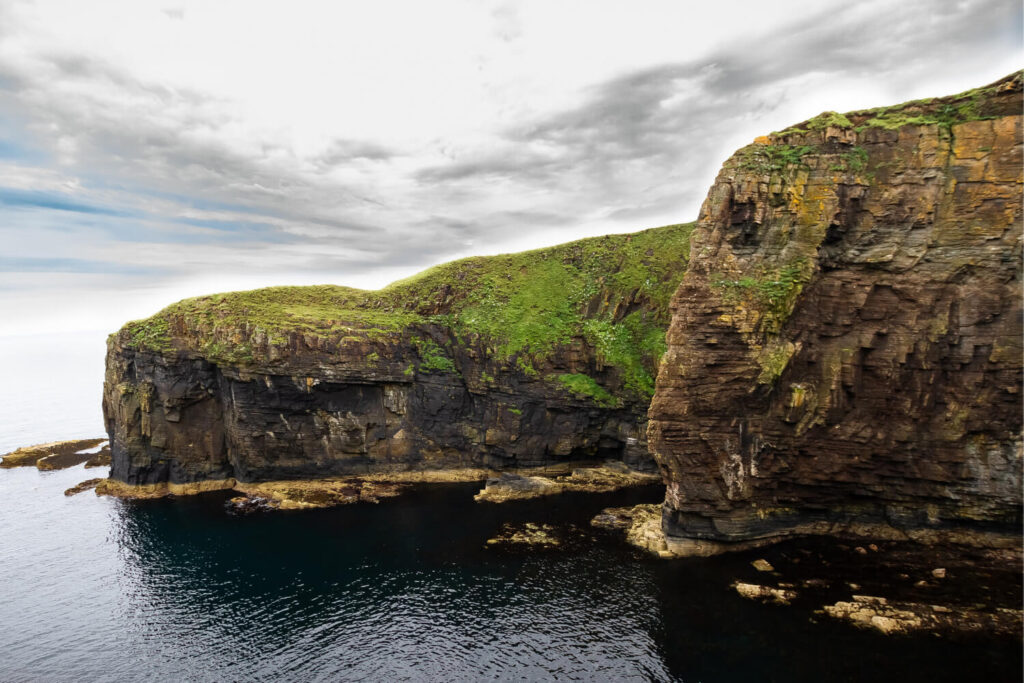
Where are the Whaligoe Steps?
Along the North-eastern coast of Scotland, the land begins to rise high above the crashing waves below. Cliffs ring this corner of the UK mainland and, luckily for us, this produces quite a number of beautiful views to admire.
South of the small town of Thrumster, you will find a small inlet of water that is sheltered snugly by the surrounding 250ft of the rock cliff face. This is known as the Whaligoe Haven and it can be found roughly 3-miles south of Thrumster or 7-miles south of the larger town of Wick.

How to Get to the Whaligoe Steps?
There is not a lot of signposting to this manmade phenomenon, so instead, you will have to follow signposts to the neighbouring sight, the Cairn o’ Get. Across the road from the signpost that reads “Cairn o’ Get”, you will see a small cafe and restaurant that is the Whaligoe Steps Cafe.
The steps will take you around 5 minutes to reach the bottom and are definitely worth the climb. Unfortunately, the harbour below is not accessible for those who are not able to take the steep staircase down to the bottom. The steps are quite small in places and can be slippery when wet, so make sure you take your time when descending.
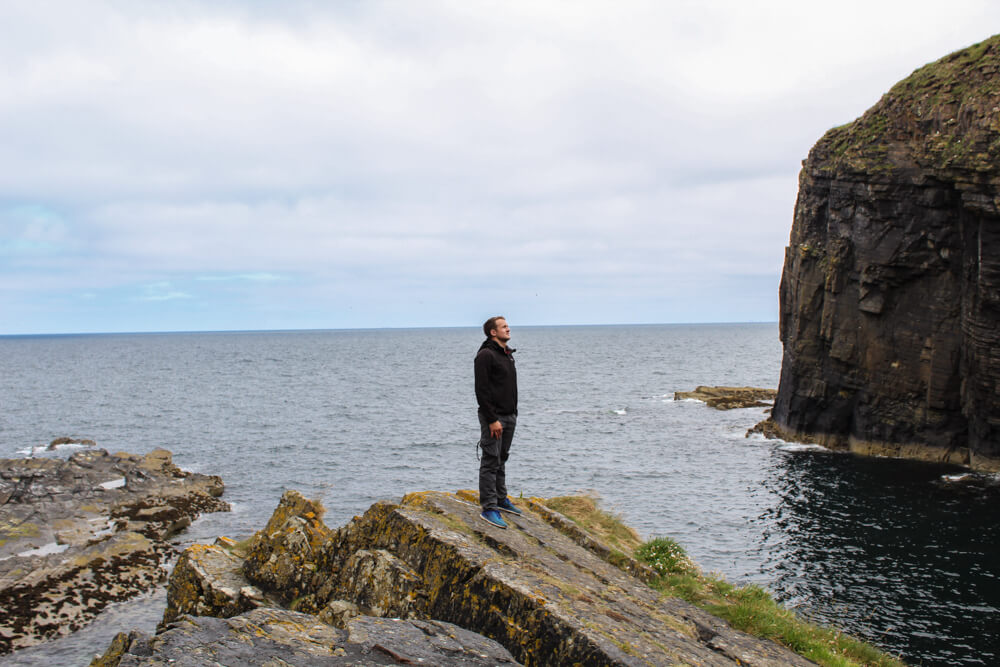
Why Should I Go to the Whaligoe Steps?
The Whaligoe Steps are a truly beautiful sight on the North Coast 500 and is possibly one of the most unique places in the whole of the UK. In recent years, the attraction has won the Shell Best of Britain Award twice and upon your visit, you will soon understand why.
As you descend the 250ft cliff using the manmade limestone steps, the world above disappears behind the towering rockface of the cliff. Below you, the waves roll in from the endless horizon and lap softly against the rocks of the harbour, echoing around the surrounding cathedral of rock.
As you reach the bottom, you begin to get a feeling for what life would have been like here 200 years ago, as the fisherman brought in their daily catch. Once landed, the job was then passed to the wives and daughters of the fishermen, who would sort the fish out for the local market, scaling and gutting the Herring, Cod, Haddock and Ling, before loading it into baskets and carrying up the 330 steps to the top.
Today, all that remains of this ancient world is a small ruin of a building at the sea end of the harbour, as well as the remains of an old boat winch that would have been used to launch and retrieve vessels. These remnants, as well as the steps themselves, are part of what makes Scotland such an enchanting place to visit. A place where even time travel is possible, as you lose yourself in the historical tales that the land has to behold.

When Should I Go to the Whaligoe Steps?
There is no time, in particular, that is the best or worst for the Whaligoe Steps, however, if I was to choose a time of day, I would say at dawn. Given its easterly position and outlook, Whaligoe Harbour is an obvious choice for any sunrise chasers out there, and it is a beautiful place to come to watch the sunrise over the ocean.
With regards to the season, the best time of year to visit the North Coast 500 is definitely between the months of May and September. During the early summer months of May and June, the weather tends to be drier and the route less busy with tourists as the schools are not on holiday. This is also the best time to visit the highlands of Scotland since the bugs have not yet come out to play.Later in the summer is also a good time to visit, with the most popular time being July, as this is when the majority of the UK has school holidays. If you can avoid this time of year, we ask that you try your best to do so to prevent over-tourism and damage to the local environment.

Things to do near the Whaligoe Steps
There are loads of other beautiful sights that you will need to visit close by to the Whaligoe Steps, both to the west and further to the south. For a full list of all of the best North Coast 500 sights that you cannot miss, read our full guide here.
Castle of Old Wick
Castle of Old Wick sits just 15 minutes on from the Whaligoe Steps and is one of the many castles on the NC500. This castle ruin sits on an outcrop of land from the surrounding cliffs, with perilous drops on either side. The Castle of Old Wick is believed to date back to the 12th century, however, all that remains today is the towering ruins of the 4-storey tower.
At the time of its construction, the Kings of Norway dominated this area of Northern Scotland. It is believed to have been built Earl Harald Madadson, the earl of Orkney, with intention of the castle being his chief seat on the mainland.
The sign-posting for this castle isn’t too great, but if you use Google Maps you should find it. Turn right onto Old March Road and continue all the way along to the end (take it slow, it gets quite bumpy!). You should see the castle once you reach the end of the road, so park up and walk it from there.
There are some stunning views of the cliffs in this part, however, don’t stand too close as they are corroded underneath and it’s a long way down! Head around the cliff till you reach the gate and head on through to the castle.

Visit Castle Sinclair Girnigoe
Further to the south of the Duncansby Stacks sits one of Scotland’s most spectacular castle ruins, the Castle of Sinclair and Girnigoe. Perched on the edge of the sea cliff, this 500-year old castle ruin has a simply fascinating history of battles, prosperity and eventual abandonment.
Just imagine what it must have been like 500 years ago, sitting in the towers of this majestic castle and looking out beyond the endless horizon. What must they have thought lay beyond that distant blue line?
Read our full guide to Castle Sinclair Girnigoe to plan your trip to the fullest.

Duncansby Stacks and Lighthouse
Situated on the farthest reach of the northern coast of Scotland, nearby the most northernly point of Dunnet Head, is the incredible sight of the Duncansby Lighthouse, situated beside the Duncansby Stacks. Built at the beginning of the 20th century to guide boats through this perilous stretch of water, known by the title of “Hell’s Mouth”. The danger in this part of the coastal waters comes from the characteristics produced by the way the Atlantic and North Seas meet, producing eddies and flows that reach up to 10 knots.
As a result of this lively water flow, the coastal scenery around Duncansby Head is some of the most spectacular in Scotland. The main spectacle being the Duncansby Stacks, the largest of which towers 60m above the water below. The true power of the weather up here is evident in the awe-inspiring coastal towers. Over thousands of years, the winds and flows of the ocean have slowly carved the coastline down to what remains today.
The lighthouse at Duncansby is still in use today, however, it remains unmanned ever since it was fully automated in 1997.

Before You Leave on the North Coast 500
Before you head off on your trip around the NC500, there are certain things you will need to get organised to ensure a smooth trip. These include how to get around the route, including being aware of single track roads, etc., what to pack for Scotland, where to stay along the route and what travel insurance to book.
How Do I Get Around?
Given the remote location of the NC500 and the majority of the sights along the route, the best way to get around this road trip is by driving. There are of course other methods that are still popular, such as cycling and hiking, however, if you have a short amount of time on the route, neither of these are very suitable.
As for public transport, the use around the NC500 is understandably difficult due to how remote each location is, however, with the increasing problem of congestion along the route, this is a good option to research if you have time. If it is something that interests you, you can read a public formed itinerary of how to get around the NC500 by public transport over here.
If you are looking to rent a cosy, reliable and luxurious campervan for your trip along the NC500, we highly recommend hiring through Bunk Campers. We toured with these guys around the up-and-coming Heart 200 road trip in Scotland’s central highlands and could not believe the comfort and customer service we experienced with their vans.
Browse the full range of vehicles on offer at Bunk Campers over here.

Where to Stay on the NC500
There is a wide range of accommodations around the NC500 route, so you will not be short on options. Depending on how long you are spending in each area will depend on how long you spend in that location. It is worth bearing in mind that some accommodations will require you to stay a minimum number of nights so it is worth researching this when you are planning your North Coast 500 itinerary.
Our new book North Coast 500 Where to Eat and Stay shares the best places to eat and stay around the NC500 and includes whether places are dog friendly, accessible, have wifi and EVC ad whether they cater to dietry requirements.
The remoteness in the highlands of Scotland will leave you with little choice of accommodation in each location along the NC500, however, there are still enough options to choose from to ensure a comfortable trip. These are mostly in the shape of B&Bs, Airbnbs, converted cottages and other quirky accommodations.
Depending on how adventurous you are, there may be more accommodation choices than just the above, often with an even better view. Caravan and camping sites are abundant along the NC500, drawing camping enthusiasts from all over the world. For some of the most spectacular bedside scenery along the North Coast 500, we recommend packing a tent and getting in touch with nature for the week.
As we travelled along the North Coast 500, camped in our trusty Vango tent on a mixture of campsites and wild sites. Wild camping is a fantastic way to enjoy the beauty of the highlands, however, it must be done respectfully. Read our full guide to Wild Camping if you wish to give it a go so you know everything you need to for a comfortable and sustainable trip.
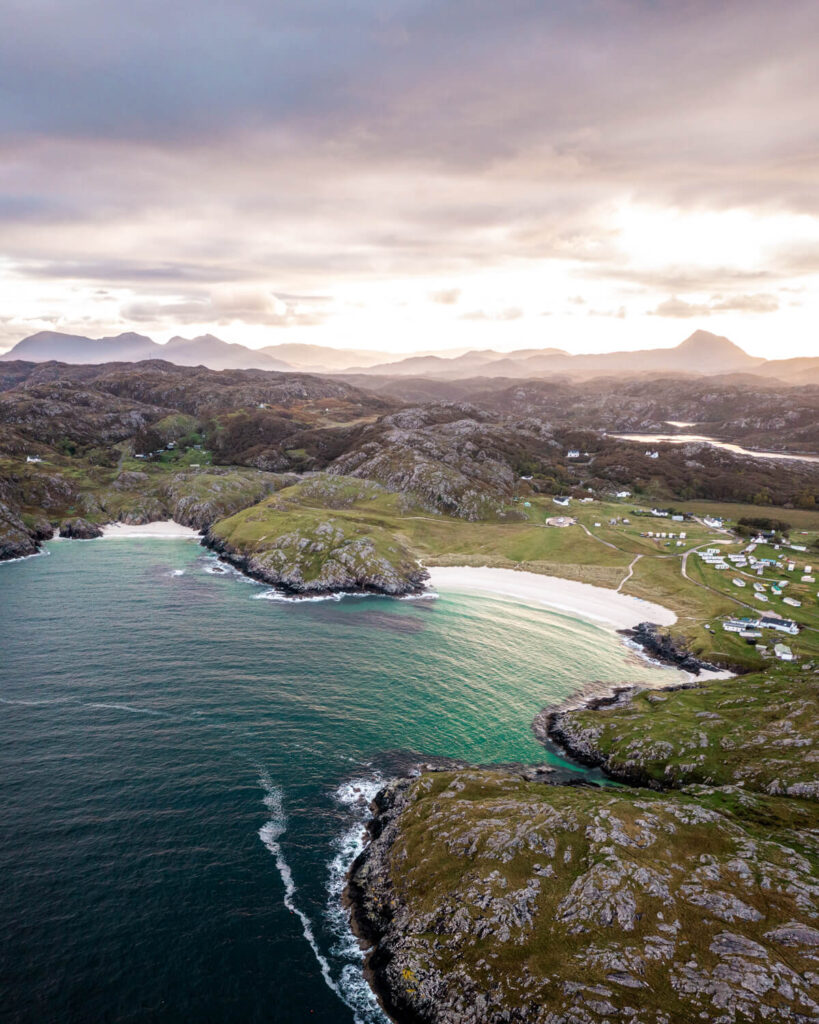
What Should I Pack?
When it comes to packing for a trip to Scotland there is one item of clothing that you are going to need all year round: a waterproof. It rains in Scotland on average 250 days a year, meaning that during your 5-day Heart 200 road trip you will probably experience at least a drizzle of rain. Due to this, the number one item on any Scotland packing list is a good waterproof jacket.
As for the rest of the year, the temperature in Scotland and the central heartlands is reasonably mild for most of the year. During the winter months, you will most likely experience snow, however, temperatures usually sit around freezing, so it is not too cold. For your reference, the average temperatures in Scotland are listed below during each season.
Spring (March, April, May) – 5-10 degrees C
Summer (June, July, August) – 15 degrees C
Autumn (September, October, November) – 5-10 degrees C
Winter (December, January, February) – 0-5 degrees C
As you can see, the weather never really gets above the teens, with anything over 25 degrees C considered a heatwave. The best way to pack for your trip to the highlands is with layers that can be added and removed as you need them. You will definitely need a hat and gloves during the colder months and will most likely need sunscreen to protect you on the long days in the open.
We would also recommend taking our NC500 guidebooks with you on your journey. This will help you plan your itinerary and ensure that you don’t miss out on any of the best places to go on the NC500. Our Destination NC500 guidebook is well paired with NC500 Where to Eat and Stay and you can buy the combo here.
Given the beautiful sights and scenery that you are no doubt going to see around Scotland, we highly recommend packing a good camera for your trip. If you want to read more about the cameras we use and why we love them, check out the link below.
Photography Equipment
Main Photography Camera – Sony A7v Mirrorless Camera and Sony A7iii Mirrorless Camera
Microphone – Sony Mic ECM-B1M
Main Lens – Tamron 17-28mm f/2.8
Zoom Lens – Tamron 70-180mm f/2.8
Camera Tripod – ZOMEI Z669C Camera Tripod
Gorilla Pod – JOBY JB01507-BWW GorillaPod
Action Camera – GoPro Hero 11 and Insta 360 One RS
Drone Camera – DJI Mavic Pro 3
Camera Bag – Wandrd PRVKE 41L and The Nest by Tropicfeel
Phone Tripod – Manfrotto MKPIXICLAMP-BK, Mini Tripod with Universal Smartphone Clamp
Sturdy Phone Tripod & Selfie Stick – ATUMTEK 61″ Selfie Stick Tripod, Sturdy Phone Tripod Stand with Wireless Remote
Hard Drives – LaCie Rugged Mini, 5TB, 2.5″, Portable External Hard Drive
SSD – SanDisk Extreme Pro 1TB Portable NVMe SSD
Travel Adapter –Worldwide Travel Adapter Universal Travel Plug with 4 USB Ports+Universal AC Socke
What is the Best Travel Insurance for the North Coast 500
I know travel insurance is the least enjoyable thing to purchase and look at when you’re planning a trip, however, you wouldn’t want to be without it in the event that something happened. Accidents can happen anywhere and the extortionate medical bills will ruin your trip if you are not covered.
To ensure you have a stress-free trip with no worries about potential medical bills, make sure you cover yourself when you travel. We can recommend using SafetyWing, a backpacker-friendly and cheap insurance company that provides good coverage and support. It is also nomad-friendly, unlike most other insurance companies, meaning you do not need to worry about being out of your home country for too long.
Get a quote for your travel insurance right here and get covered!

So there you have it, a complete guide to visiting the Whaligoe Steps. If you have visited the NC500 recently, let us know what you thought of the sights listed above, or if you have any suggestions let us know in the comments below.
As always, sharing is caring so make sure to share this guide with your family and friends and inspire them to head off on their own North Coast 500 adventure. If you are planning the trip for yourself, make sure you have a look at the rest of our Scotland content for more inspiration to our beautiful home country.
When you set off on your own adventure, be sure to tag us in your photos on Instagram and we will share them with the rest of our community. In the meantime, why not follow us over there to see what we are currently up to and keep up with us on our Instagram Stories.
Now Read:
This article may contain affiliate links that provide us with a small income. For more information read our Affiliate page.
Pin it for later!



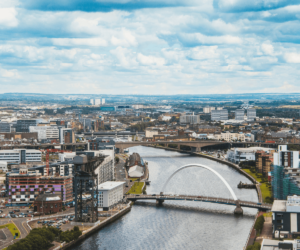
Pingback: Instagram Guide to the North Coast 500 - Most Photogenic Spots | highlands2hammocks